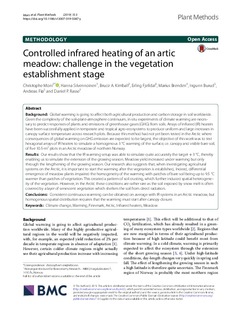| dc.contributor.author | Moni, Christophe | |
| dc.contributor.author | Silvennoinen, Hanna Marika | |
| dc.contributor.author | Kimball, Bruce A. | |
| dc.contributor.author | Fjelldal, Erling | |
| dc.contributor.author | Brenden, Marius | |
| dc.contributor.author | Burud, Ingunn | |
| dc.contributor.author | Flø, Andreas Svarstad | |
| dc.contributor.author | Rasse, Daniel | |
| dc.coverage.spatial | Finnmark, Norway | nb_NO |
| dc.date.accessioned | 2019-09-05T11:17:16Z | |
| dc.date.available | 2019-09-05T11:17:16Z | |
| dc.date.created | 2019-04-26T10:11:48Z | |
| dc.date.issued | 2019-01-19 | |
| dc.identifier.citation | Plant Methods. 2019, 15 1-12. | nb_NO |
| dc.identifier.issn | 1746-4811 | |
| dc.identifier.uri | http://hdl.handle.net/11250/2612645 | |
| dc.description.abstract | Background: Global warming is going to affect both agricultural production and carbon storage in soil worldwide. Given the complexity of the soil-plant-atmosphere continuum, in situ experiments of climate warming are necessary to predict responses of plants and emissions of greenhouse gases (GHG) from soils. Arrays of infrared (IR) heaters have been successfully applied in temperate and tropical agro-ecosystems to produce uniform and large increases in canopy surface temperature across research plots. Because this method had not yet been tested in the Arctic where consequences of global warming on GHG emission are expected to be largest, the objective of this work was to test hexagonal arrays of IR heaters to simulate a homogenous 3 °C warming of the surface, i.e. canopy and visible bare soil, of five 10.5-m2 plots in an Arctic meadow of northern Norway. Results: Our results show that the IR warming setup was able to simulate quite accurately the target + 3 °C, thereby enabling us to simulate the extension of the growing season. Meadow yield increased under warming but only through the lengthening of the growing season. Our research also suggests that, when investigating agricultural systems on the Arctic, it is important to start the warming after the vegetation is established,. Indeed, differential emergence of meadow plants impaired the homogeneity of the warming with patches of bare soil being up to 9.5 °C warmer than patches of vegetation. This created a pattern of soil crusting, which further induced spatial heterogeneity of the vegetation. However, in the Arctic these conditions are rather rare as the soil exposed by snow melt is often covered by a layer of senescent vegetation which shelters the soil from direct radiation. Conclusions: Consistent continuous warming can be obtained on average with IR systems in an Arctic meadow, but homogenous spatial distribution requires that the warming must start after canopy closure. | nb_NO |
| dc.language.iso | eng | nb_NO |
| dc.rights | Navngivelse 4.0 Internasjonal | * |
| dc.rights.uri | http://creativecommons.org/licenses/by/4.0/deed.no | * |
| dc.subject | Climate change | nb_NO |
| dc.subject | Warming | nb_NO |
| dc.subject | Finnmark | nb_NO |
| dc.subject | Arctic | nb_NO |
| dc.subject | Infrared heaters | nb_NO |
| dc.subject | Meadow | nb_NO |
| dc.title | Controlled infrared heating of an artic meadow: challenge in the vegetation establishment stage | nb_NO |
| dc.type | Journal article | nb_NO |
| dc.type | Peer reviewed | nb_NO |
| dc.description.version | publishedVersion | nb_NO |
| dc.subject.nsi | VDP::Landbruks- og Fiskerifag: 900 | nb_NO |
| dc.source.pagenumber | 1-12 | nb_NO |
| dc.source.volume | 15 | nb_NO |
| dc.source.journal | Plant Methods | nb_NO |
| dc.identifier.doi | 10.1186/s13007-019-0387-y | |
| dc.identifier.cristin | 1694082 | |
| dc.relation.project | Norges forskningsråd: 225135 | nb_NO |
| cristin.unitcode | 7677,4,0,0 | |
| cristin.unitcode | 7677,2,0,0 | |
| cristin.unitname | Divisjon for miljø og naturressurser | |
| cristin.unitname | Divisjon for skog og utmark | |
| cristin.ispublished | true | |
| cristin.fulltext | original | |
| cristin.qualitycode | 1 | |

